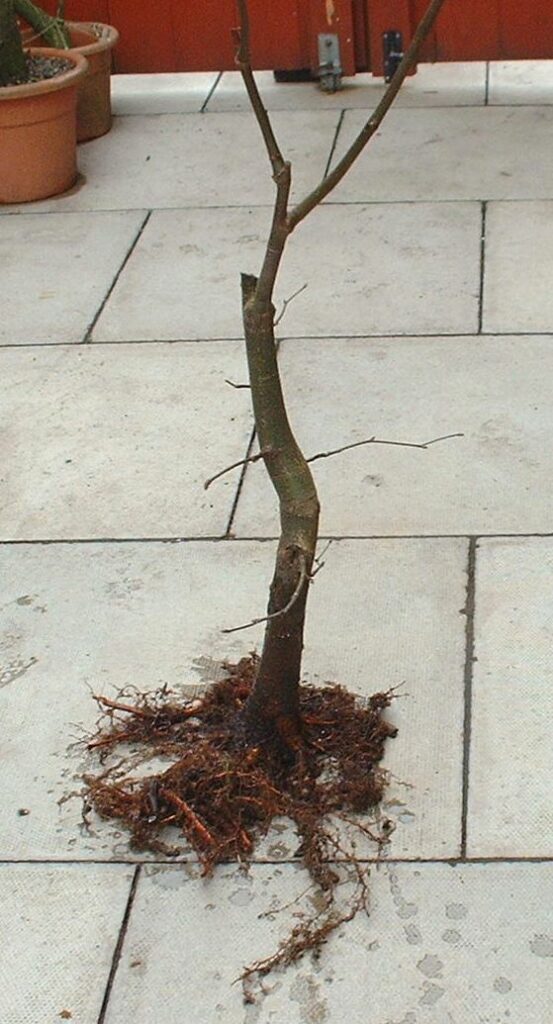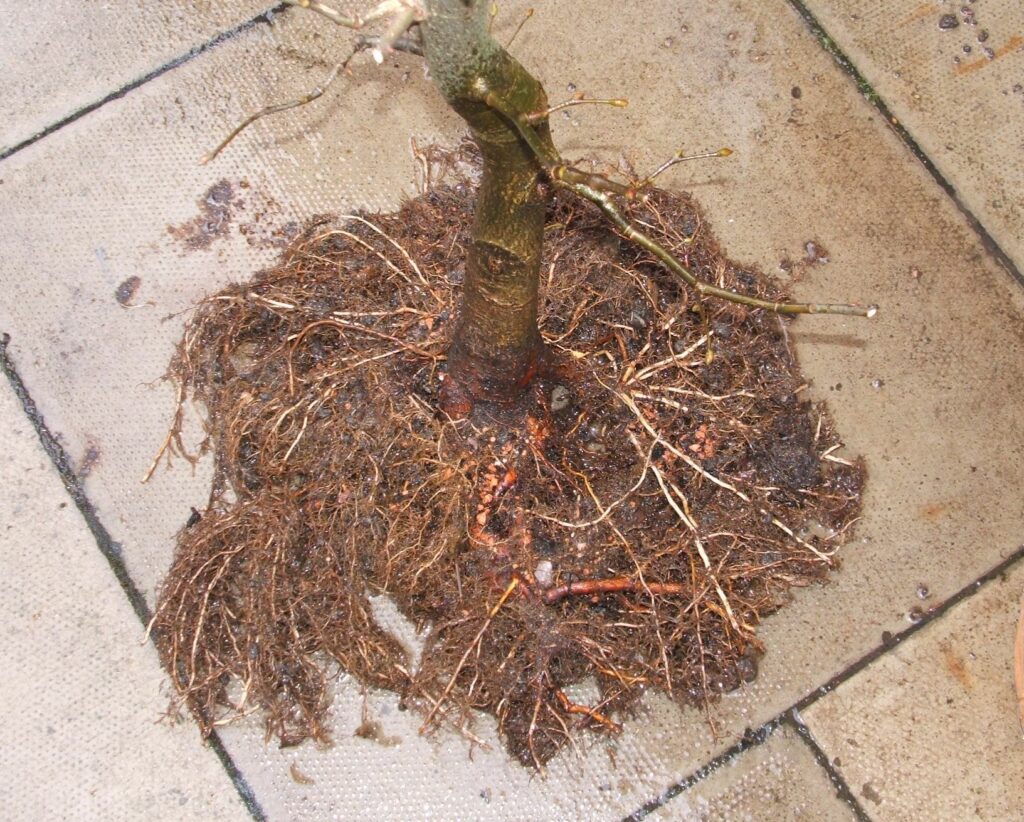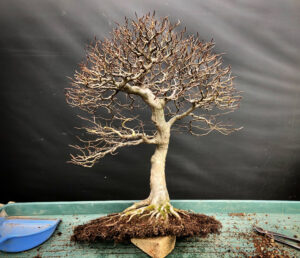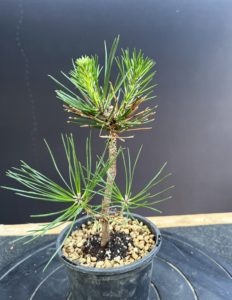A common misconception amongst newcomers to the art of bonsai is that trees (bonsai) with large, thick trunks must have had decades of training to become the size they are and that a thin-trunked seedling will one day acquire a thick mature trunk even though it is planted in a bonsai pot.
Unfortunately, once a tree is growing in the confines of a small pot, with its roots restricted and upper growth regularly pruned, the trunk and branches of the tree will only thicken slowly.
Large bonsai with thick trunks are nearly always developed in the ground prior to being planted into a pot; some are purposely field grown, some are collected mature trees.
As a tree develops new growth during the growing season, it lays down new wood to feed and supply its new shoots and leaves. The more new shoots and foliage the tree produces, the more new wood is developed to support this new growth. This new wood grows around the outer ring of the trunk and branches in an almost direct passage from the new shoots, back through the trunk to the root system, gradually increasing the trunk’s diameter. Therefore, the greater the amount of new growth a tree achieves in a season, the greater the increase in the girth of its trunk.
A tree that is allowed unrestricted growth will always thicken faster than a tree that is pruned.
The best way to promote unrestricted growth in any tree or shrub is to plant it into the ground; a large container is an alternative but not equivalent to growing in the ground. (This is chiefly due to the difference in dynamics of soil held within a container and that of a large mass of ground-soil; be wary of planting trees in overly large containers, this can in fact slow growth. See Overpotting).
Field-growing techniques can be used within any area of ground, if an area of land is unavailable to you (as is often the case) trees can be grown on (and enjoyed) in the garden amongst ordinary garden schemes, as ‘temporary’ 5-10 year hedges or as ‘temporary’ garden specimens. It is also possible with a little work to build raised beds specifically for the purpose of field growing; raised beds can be walled with brick or wooden planks and filled with good quality soil.
Any tree/shrub species can be used for field growing as long as it is hardy in your local climate. Native species naturally thrive in your local climate and will therefore respond to give the best results; other species will develop well but can take longer to establish in the ground before growing with real vigour.
Any age or size of tree is suitable for field growing as long as it is well developed enough to compete with any grasses or weeds that might compete for light or moisture. Generally, cuttings, seedlings or saplings should be at least 2 years old before planting out unless you are able to cosset them for the first year.
Growth rates to expect
Typically, trees will spend the first year establishing in the ground with some reasonable top growth. The second year will start to show strong growth and bulking up of the trunk. By the third year you should expect to see extremely vigorous growth; some species such as Trident Maples, Elms and Hornbeam will have easily reached heights of 12ft+ by now if left unpruned.
With regard to the trunk diameter, quick growing species such as Tridents, Field Maples, Hornbeam, Elm and Scots Pine can see an increase in trunk diameter from 1/2″ as saplings to 2″ to 3″ at the end of their third year in the ground. Peter Chan of Heron’s Bonsai has described how a 1″ diameter Field Maple he planted into the ground 18 years previously, had achieved a 15″ trunk!
Nebari and root techniques
If the tree you are planting has downward growing roots or poor surface roots, consider ground layering it by tying a wire around the base of the trunk. If there is already a good root pattern and strong lateral roots, prune the rootball so it is reasonably shallow and plant the tree on top of a tile, brick or flat piece of wood. As the tree grows, new roots will be unable to grow downwards and the resulting lateral rootgrowth will ensure the tree is easier to collect and have a much improved root spread and nebari.
This Tilia cordata or Small Leaved Lime has been planted on top of a tile in the ground for the past 4 years. Last Spring it was lifted and root pruned for the first time. As can be seen below, a year later the result is a flat rootball with strong lateral root growth, ideal for bonsai.

Linden in 2002 after growing on top of a tile in the ground for 2 years.

The same Linden in 2005 after growing on top of a tile in the ground for 5 years.

The development of the nebari after 5 years.

The Linden in 2016 after full development of the trunk, the branch structure and nebari, plus much more ramification!
Our Online Shop is owned and run by bonsai artist and author Harry Harrington..
For bonsai supplies, soils, books, tools and bonsai for sale!
General care and maintenance of Field-Growing Trees
One of the benefits of field growing is that a large number of trees can be planted out for future use as bonsai and left to their own devices without the need for high maintenance care.
Before planting, improve the condition of the soil though it is not necessary (or possible) to expect a soil of the standard used for container growing. Clay soils should be improved by adding grit, sand or compost to open up the soil and improve drainage, thin gritty soils should have compost added to improve water retention and nutrition.
For their first season after planting out or after rootpruning, care must be taken that the ground is not allowed to dry out more than a couple of inches below the soil surface as the rootsystem will not have had a chance to extend in search of moisture. However, do not keep the soil continually wet as this will actively discourage the roots to grow in search of moisture, making the tree less drought resistant.
Trees over 3 or 4 ft that have shallow a rootsystem should be staked to guard against being upturned by the wind. Tie the tree to a stake using tree-ties to reduce damage to the bark on the trunk. Try to tie the tree low down on the trunk; though it is necessary to steady the base of the tree to stop the roots being disturbed by the wind, repeated flexing of the upper part of the tree in the wind will help thicken the trunk.
Keep weeds that grow around the trees to a minimum especially around young trees that may not be established enough to compete for light or water. Be wary of weeds that might shade out and cause the eventual dieback of lower branches.
Weed suppressing membranes can be used on the soil surface prior to planting; this will keep weed growth to a minimum but can cause difficulties in future years when trying to rootprune or collect your trees. It should also be noted that the presence of low-growing weeds will be of no detriment to the tree and can greatly reduce the time it takes for mature bark to appear.
Regular feeding of field growing trees is unnecessary though they do benefit from one application of Growmore (or similar slow-release fertiliser) in the Spring and one in the Summer, particularly on thin, stony soils.
Pruning Field Grown Trees
Primarily, the purpose of field growing is to develop a thick trunk base and nebari. Until the trunk has developed, there is no need to consider the final branch positions (unless the tree is coniferous). Ordinarily, once the trunk has reached its final size and girth, all branching will be too thick for use as bonsai and will need to be removed and restarted.
Avoid continually interfering with your tree! Any pruning will result in less growth and less increase in trunk diameter. Bear in mind that the more growth the tree carries, the thicker the trunk will become and the more growth it will put out during the forthcoming season.
The only pruning that should be necessary is during the Winter in order to control or redirect the trunkline depending on how you envisage the finished trunk to look. (An article on developing field-grown tree trunklines can be found here).
Rootpruning Field Grown Trees
Rootpruning your field grown trees will slow down their growth rate and negate the purpose of field growing. However, it is important that the future nebari and root structure is developed or there is a risk that your fat field-grown trunk will be ruined by a poor nebari.
Rootpruning should be carried out in early Spring as with bonsai. Roots should only be pruned to encourage a good nebari. Every second or (preferably) third year, lift the tree and examine the root structure. Any roots close to the trunk that are felt to be unsuitable for future use (for instance crossing roots, roots growing at poor angles from the trunk, a thick over-dominant root or very straight roots with little branching or taper) can be removed. Unless you have had the foresight to plant the tree on top of a tile, it is also important to remove or at least shorten any downward growing roots. Try to remove as little root as possible and no more than a couple of major roots in one year.
In the last year or two before finally lifting the tree to begin bonsai training, cut around the base of the tree with a spade in early Spring to encourage finer root growth closer to the trunk.





